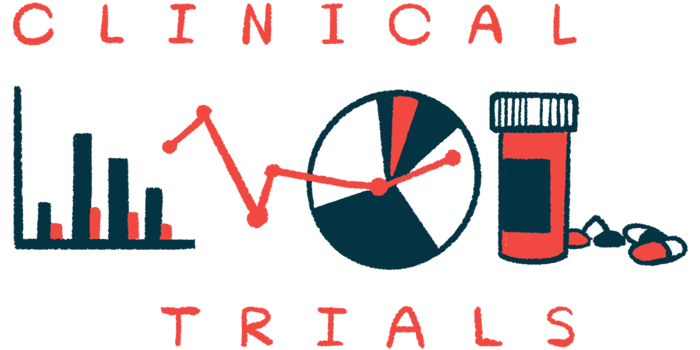Oral therapy moves to follow-up after strong data in DMD adults
Dosing has begun in new study, which will track strength gains of SAT-3247

Note: This story was updated Nov. 5, 2025, to clarify that enrollment in the follow-up study is ongoing.
Dosing has begun in a long-term follow-up study testing Satellos Bioscience’s experimental oral therapy SAT-3247 in men with Duchenne muscular dystrophy (DMD).
The study — called LT-001 (NCT06867107) — plans to enroll patients who completed a previous Phase 1 trial (NCT06565208), where SAT-3247 was shown to improve measures of muscle function after about a month of treatment. Satellos said the follow-up is expected to enroll up to 10 new participants in Australia, as well as participants in the U.S., pending regulatory approvals.
“What we hope to see in this study is sustained or continued functional improvement in metrics that matter for these adults, and of course the long-term potential of SAT-3247,” Frank Gleeson, co-founder and CEO of Satellos, said in an interview with Muscular Dystrophy News.
In a company press release, Gleeson said that dosing the first patient in the follow-up study “marks an important milestone as we work to unlock the long-term potential of SAT-3247 for people living with Duchenne.”
Targeting the root cause of muscle damage in DMD
DMD is caused by mutations that impair the production or function of dystrophin, a protein that acts like a shock absorber to protect muscle fibers from damage. Without adequate dystrophin, muscles become more vulnerable to stress and progressively deteriorate.
Research has indicated that dystrophin isn’t only important for muscle fibers. Satellos’ co-founder Michael Rudnicki, PhD, and his team found that it’s also important for muscle stem cells, which are crucial for muscle repair.
When muscles are injured, muscle stem cells undergo a process called asymmetric division. This process means one stem cell divides to make two new cells: one that contributes to repair by making new muscle tissue, and another that will keep the repair cycle going. But without dystrophin, this process becomes dysregulated, leaving too few stem cells to sustain muscle repair.
“This deficit in the natural repair process of muscle generation is a key contributor to disease progression and accumulating muscle loss in Duchenne,” Gleeson said. “We can now view Duchenne as a muscle stem cell disease where these critical cells do not appropriately support regeneration.”
SAT-3247 is designed to restore normal asymmetric division by blocking the activity of a protein called AAK1.
“Through methodical scientific study of muscle stem cell division, we found that by blocking a protein called AAK1, muscle stem cell asymmetric division may be ‘reset.’ Based on this science, we invented and designed SAT-3247 as a selective AAK1 inhibitor for the treatment of Duchenne and potentially other degenerative muscle conditions,” Gleeson said.
Early trial shows stronger grip, better breathing in adults with DMD
The completed Phase 1 study tested the safety of SAT-3247 in healthy volunteers and then in five adults with DMD, ages 20 to 27. Gleeson noted those with DMD could not walk, and the study was designed with this in mind.
“In this stage of disease, often the last muscles adults must rely on are in their diaphragm, hands, and forearms. This informed pursuing measures like grip strength and forced vital capacity,” he said. “These areas of muscle function become very important to adults with Duchenne as the disease progresses.” Forced vital capacity is a measure of lung function based on how much air someone can blow out with a forceful breath.
Gleeson added that “an interesting aspect of evaluating SAT-3247 in adults with Duchenne is that any signs of efficacy and improvement are particularly significant as they have been observed in a population with an advanced stage of disease.”
The Phase 1 study showed that after almost a month of treatment, patients’ grip strength doubled — from roughly 2 kg (4.4 lbs) to 4 kg (8.8 lbs) in each hand. Gleeson said this type of improvement “may support such tasks as writing, handling utensils, or managing daily items.”
“We can definitively say that any degree of functional improvement associated with a stronger grip would be incredibly meaningful to an adult with Duchenne, as that individual likely has an extremely high reliance on their hands in this late stage of disease,” he added.
Studying a younger participant population will allow a broader range of functional measurements to be explored, given this group is much more mobile than the participants in our Phase 1b trial. And this ultimately aligns with our goal to bring this to as many people living with Duchenne as possible.
Safety data from the Phase 1 study were overall positive, with only mild side effects such as nausea, abdominal pain, and lightheadedness. Forced vital capacity improved by a mean 5.8% after four weeks on SAT-3247. For comparison, Gleeson said an improvement of 4% over the course of a year is considered clinically meaningful. Untreated adults with Duchenne normally show 5% declines in this measure over one year, Satellos said.
“This suggests a potentially relevant physiological effect that warrants further study. This is one reason we have moved to extend the [Phase] 1b study by a further 11 months,” Gleeson said.
In the follow-up study, participants will be treated with SAT-3247 for an additional 11 months. The study will also enroll more males with DMD, ages 16 to 25.
The study’s main goal is to assess safety, but it will also be evaluating muscle function and muscle composition by MRI.
Satellos also plans to launch a Phase 2 clinical trial testing SAT-3247 in children with DMD who can walk. “We are committed to developing a medicine for people of all ages living with Duchenne,” Gleeson said. He added that regulatory reviews are underway, and Satellos hopes to have interim data in 2026.
“Studying a younger participant population will allow a broader range of functional measurements to be explored, given this group is much more mobile than the participants in our Phase 1b trial,” Gleeson said. “And this ultimately aligns with our goal to bring this to as many people living with Duchenne as possible.”
“If we are able to modulate the natural muscle repair and regeneration process within the body, it may be possible to help many individuals recover much-needed function in their daily lives,” Gleeson concluded. “Importantly, our therapeutic can also be complementary to other innovative approaches in Duchenne.”







